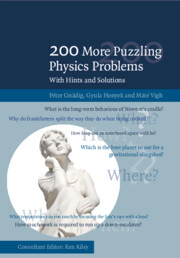How to use this book
Published online by Cambridge University Press: 05 May 2016
Summary
This book has a two-fold objective: to teach and train students, and to intrigue and entertain everybody who likes physics and puzzles. The first chapter contains the 200 problems. If the reader's main objective is to use the book as a basis for studying physics, we recommend that the problems are tackled in the order they appear, though this does not necessarily represent their order of difficulty. Of course, if the reader is using the book for fun or as a challenge, he or she can freely ‘cherry-pick’ the questions.
It is an essential part of a physicist's skill to be able to recognise the type of problem in front of them, and to identify which areas of science and mathematics will need to be called upon. Almost needless to say, some of the problems could not be unambiguously assigned to, say, mechanics or gravitation or electromagnetism. Nature's secrets are not revealed according to the chapter titles of a textbook, but rather draw on ideas from various areas, and usually in a complex manner. However, after the present section, for information, we have included a list of topics, and the numbers of the problems that more or less belong to those topics. Some problems are listed under more than one heading. A list of symbols and numerical values for the principal physical constants, as well as several tables of material and astronomical data, not all of which will be needed, are provided in the Appendix at the end of the book. The Appendix also contains many standard mathematical results, drawn from the areas of vector algebra, conic sections, trigonometry, calculus and solid geometry.
The majority of the problems are not easy; some of them are definitely difficult. You, the reader, are naturally encouraged to try to solve them on your own and, obviously, if you do you will get the greatest satisfaction. If you are unable to achieve this, you should not give up, but turn to the relevant page of the hints in the short second chapter. In most cases this will help, though it will not give the complete solution, and the details will still have to be worked out. Once you have done this and want to check your result (or if you have given up and just want to see the solution) the final chapter should be consulted.
- Type
- Chapter
- Information
- 200 More Puzzling Physics ProblemsWith Hints and Solutions, pp. xiii - xivPublisher: Cambridge University PressPrint publication year: 2016



